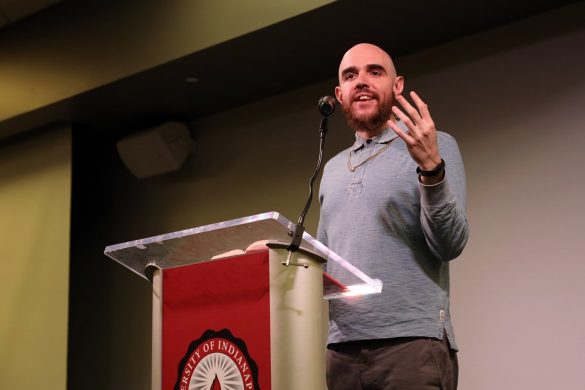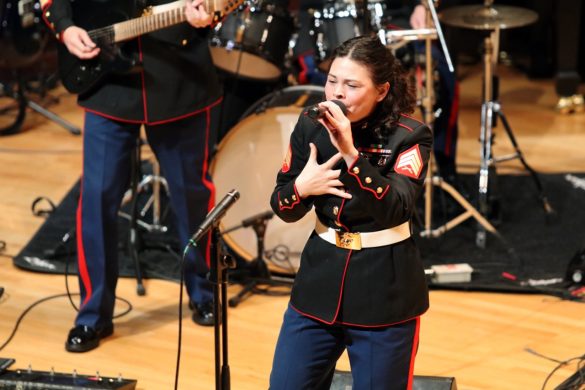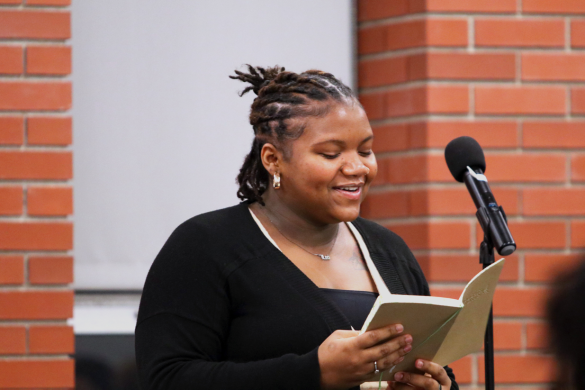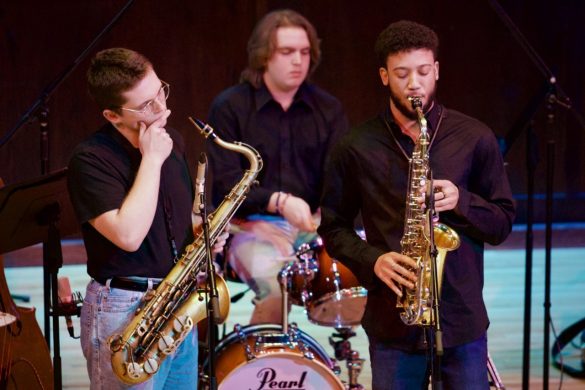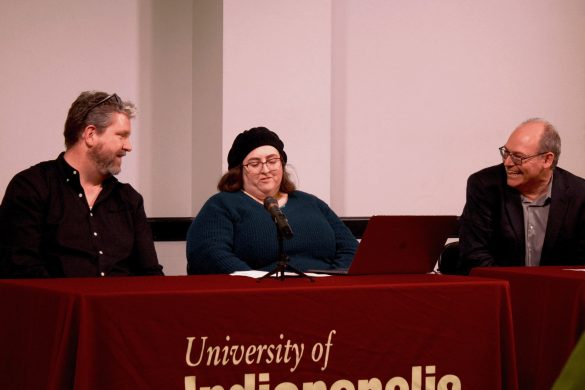
Clayton Rardon (left) played Victor Frankenstein and Marcus Sciarra (right) played Frankenstein’s creature in UIndy Department of Theatre’s production of “Frankenstein.”
Photo By Cassie Reverman
In celebration of the upcoming bicentennial of the novel, “Frankenstein” is being performed by the University of Indianapolis Department of Theatre in connection with the Community Frankenstein Course. The play is based on Mary Shelley’s 1818 book and adapted for the stage by Austin Tichenor.
Chair and Director of Theatre and Associate Professor of Theatre Brad Wright said that the “Frankenstein” novel is very literary because it is a story within a story, including being told through letters and at one point from the creature’s perspective. Assistant Professor of Theatre Casey Kearns said the adaptation as a play is very cinematic and moves from scene to scene quickly.
“[In the book] there’s a lot of description of the geography of where the scenes are taking place, and on stage it’s all about action,” Wright said. “That’s one of the interesting challenges of adapting literature to the stage is that non dramatic literature is narrative, by definition, it’s narration. On stage it’s all happening in the present moment so we have to focus on action so a lot of that description that’s in the book is missing because it’s not being narrated.”
“Frankenstein” begins with a young scientist, Victor Frankenstein, being found by the crew of a ship in the Arctic. Frankenstein then tells the story of how he constructed a creature. Then, ashamed of his creation, Frankenstein abandoned him. An adaptation of “Frankenstein” has to take into account what the audience expects from such a well known story and the original version, according to Wright. He said that audiences who come to see “Frankenstein” will have been exposed to the movie versions.
“[Tichenor] actually says that, in essence, he took some liberties with the adaptation because an audience coming to see something called “Frankenstein” has certain expectations,” Wright said. “For instance, in the novel there is very little if any time spent in the laboratory. In the film that’s one of the more spectacular images and scenes that the audience is going to remember and there’s more time spent in the lab than you would see in the actual novel. Hopefully the audience will react to the being true to the novel but also being true to what those expectations might be.”
Sophomore theatre and communication double major Katie Carter plays Elizabeth Lavenza, Frankenstein’s fiancee. She said it is a little bit daunting to perform in such a well known story but that it is exciting to be able to portray “Frankenstein” in a new way and break the stereotype.
“Our Frankenstein [creature] isn’t painted green, he’s just a guy. He doesn’t just make sounds, he—by act two—is educated. He’s well spoken and has wants and things that he needs. So that’s our biggest thing is that we’re not approaching him as a monster or anything or even a part of his whole character is saying, ‘I’m not a monster, I’m a person and there are things that I want.’”
According to Carter, there are about six main characters in the play and the rest are in the ensemble. She performs most of her scenes with Frankenstein who is played by freshman theatre major Clayton Rardon and Henry who is played by junior theatre education major Zech Saenz.
“We [the whole cast] were all pretty good friends prior to being cast in the show, so it was just about how people were going to be placed,” Carter said. “I think we work really well together. I think the dynamic that specifically Clayton and Zech and I have is very interesting because we’re all really good friends in real life, so I think that connection is portrayed really well on stage and helps to make the scenes more believable because the script can sometimes seem melodramatic, with [a lot of] deaths and all that stuff.”
“Frankenstein” takes place in the Romantic era in 1818. Wright said he likes the aesthetic of the time period, but also wanted to mix it with the science side of the play. Wright, Kearns and the design team went for a steampunk feel, but with the Romantic era instead of the Victorian.
“So we went with this idea that steampunk was cogs, gears, rust and interesting textures and apparatus that are composed of multiple pieces of found objects that are mechanically included,” Kearns said. “But that’s easier said than done when you’re looking at little props like furniture and trinkets and costumes, but when you’re looking at architectural statements, it’s a much broader concept that is defined. So the set became to me in this environment that provided some sort of mystery, of strange comfort to
a certain extent, something that we could play with light and contrast and shadows and mystery. So it was a space in which things could happen and preferably fluidly happen without anticipating, so that’s how we ended up with the structure that we have now.”
Carter said the costumes are very interesting and include a lot of leather and vinyl while still sticking to 1800’s style of long dresses and capes. Carter said she especially likes Frankenstein’s costume.
“I love my costume,” Rardon said. “We looked at the designs and I thought it was going to be amazing and it turned out even better than I thought it was going to be. And seeing the set, all the intricate pieces that go into and the work that it takes to get every part and every change done as quickly and as cleanly as it did it’s all just designed beautifully and it’s great. I love it.”
Carter also mentioned the panels that hang above the stage and feature scientific and anatomical drawings. Kearns said the panels are etchings from Leonardo DaVinci.
“I’ve always been fascinated with Leonardo DaVinci and I often wonder what our world would be like today if he was still alive and well and studying, providing scientific research, anatomical research and art,” Kearns said. “And what Victor Frankenstein was trying to accomplish could very much been the mindset of DaVinci at some point.
The etchings of DaVinci are the sense of awe of his mental capacity but also for me that intellectual curiosity of examining more and further, and trying to take human nature to it’s greatest potential even far beyond our own ability to
understand. So the inspiration came from wanting to incorporate his [DaVinci’s]
knowledge to that, that our audience might connect with it. Trying to put these two individuals in the same capacity and examining very similar subjects.”
According to Rardon, there is a big transition going from high school-level to college-level theatre. He said he was nervous on the first night of performances but has really enjoyed the experience.
“It was really overwhelming for a lot of it to go into it and not really know what college theatre was like. And in this first show having so many lines as a lead character, but it’s been an amazing experience,” Rardon said. “I wouldn’t trade it for anything. I love the show. I love the character. The script is really good. It’s just a lot of fun all around.”
The final showing of “Frankenstein” will be going on from Nov. 9 through 11 at 8:00 p.m. in Ransburg Auditorium. Tickets can be purchased online or before the show.
